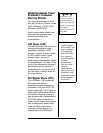
23
SS=Subfleet ID
Type I systems are usually
organized with different user
groups assigned to different
fleets.
Ô
To properly map the raw Type I
data to the correct fleet-subfleet
format, you must program the
correct fleet map into the scanner.
Fleet map information is widely
available on the Internet for most
Type I systems in use.
Type II and APCO-25 system
talkgroups are identified by a 5-
digit number. Valid Type II
talkgroup IDs are divisible by 16,
while APCO-25 talkgroups are not.
Use care to ensure that you enter
the correct Type II IDs into your
scanner. Type I/II hybrid systems
use both fleet-subfleet and 5-digit
formats for talkgroup IDs.
EDACS Trunking Mode
(ED)
You can set your scanner so it
decodes the talkgroup IDs used
with EDACS (GE/Ericsson/M/A-
COM) trunking systems. This
setting is called the EDACS mode.
EDACS systems are used
primarily by business or private
communications service providers,
as well as by some public safety
organizations. EDACS systems
transmit active talkgroup
information only on a dedicated
control channel.
EDACS frequencies are organized
in a specific order. Each frequency
is assigned a Logical Channel
Ô NOTES Ô
• For example, a valid
fleet-subfleet ID
identifying all
detectives within a
police department
might be 000-12,
where 000 identifies
all police users and
12 identifies the
Detective division.
• Tuning the scanner
to an active control
channel while in
Motorola mode will
display the Motorola
System ID and the
approximate control
channel message
decode success rate.
This information can
help you identify the
Motorola trunking
system that you are
monitoring and the
quality of the control
channel signal.


















